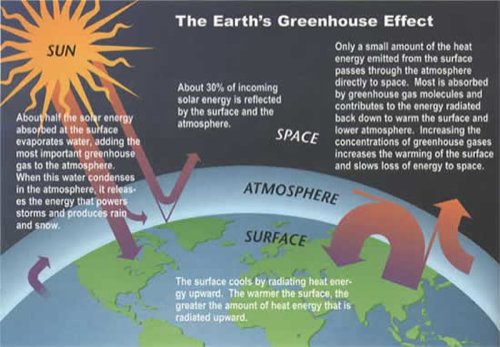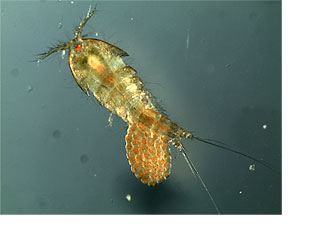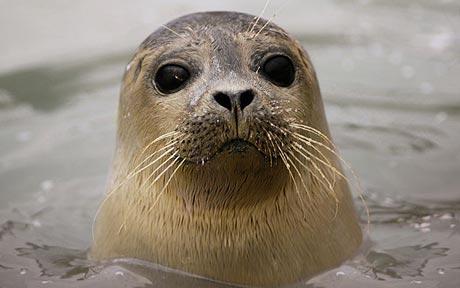What is solar radiation?
Solar radiation is essentially radiation from the sun. When solar radiation meets Earth's atmosphere, part of it is transmitted through the atmosphere, while the other part is reflected back into space. The transmitted radiation travels towards the Earth's surface, and different parts of the spectrum are absorbed by the molecules that make up the Earth's atmosphere. Once the energy that is not absorbed in the atmosphere hits Earth's surface, some of it is absorbed while the rest is reflected back into the atmosphere. About 30% of the energy is reflected by the atmosphere and the surface of the earth. This energy is known as albedo.
What is The Greenhouse Effect?
The Greenhouse Effect is the phenomenon by which Earth's atmosphere traps solar radiation. This is caused by the atmospheric gases (carbon dioxide, water vapor, and methane) which permit the incoming sunlight to pass through but do not allow the heat radiated back from the Earth's surface to pass through. Instead, the atmosphere absorbs the heat. This essentially creates a blanket over the Earth, and is responsible for the heating of the Earth to warmer temperatures that it would not be at otherwise. In fact, without the greenhouse effect, the average surface temperature of the earth would be about 60 degrees Fahrenheit cooler.

Why study marine life?
With all of the changes happening to our environment, scientists are looking at how different species are changing. Scientists study the ozone, because its depletion can cause many things, including climate change. In the area of climate change, scientists are focusing more on marine organisms because their movements are linked with their temperature ranges. Marine organisms are more sensitive to climate changes than terrestrial organisms. The smaller the marine organism, the more sensitive they are. Because of this, they tend to stay in their temperature range.
What is the response?
In an experiment done on purple sea urchins, a group of scientists found that higher temperatures caused some developmental stress. The
 urchins that were subjected to higher temperatures were significantly shorter along their animal-vegetal axis. The scientists hypothesized that this decrease in size was because of the increased metabolic demands of development at higher temperatures. The embryos also had less ordered cells in their ectoderms. However, the embryos at the higher temperatures developed through the gastrula stage, which suggests that the embryos were able to buffer their development against temperature stress. These results, however, should not be very surprising. This is because the species has a very large effective population size, high genetic variation, and an extensive gene flow among different populations living in widely varying temperature ranges.
urchins that were subjected to higher temperatures were significantly shorter along their animal-vegetal axis. The scientists hypothesized that this decrease in size was because of the increased metabolic demands of development at higher temperatures. The embryos also had less ordered cells in their ectoderms. However, the embryos at the higher temperatures developed through the gastrula stage, which suggests that the embryos were able to buffer their development against temperature stress. These results, however, should not be very surprising. This is because the species has a very large effective population size, high genetic variation, and an extensive gene flow among different populations living in widely varying temperature ranges.
 The picture on the right shows a Tigriopus californics, or copepod. In an experiment done by a UC Davis graduate student Morgan Kelly, these animals showed very little ability to Adapt in response to climate change. Kelly grew these copepods from different locations in the lab for ten generations - this is easier than it sounds, since their generation time is short. At the beginning of the experiment, the little guys showed some potential, but Kelly was only able to get them to move about a half-degree Celsius over these ten generations.
The picture on the right shows a Tigriopus californics, or copepod. In an experiment done by a UC Davis graduate student Morgan Kelly, these animals showed very little ability to Adapt in response to climate change. Kelly grew these copepods from different locations in the lab for ten generations - this is easier than it sounds, since their generation time is short. At the beginning of the experiment, the little guys showed some potential, but Kelly was only able to get them to move about a half-degree Celsius over these ten generations.
Outside of the lab, these copepods experience a very wide range of temperatures. In fact, within a day they can withstand a temperature change of 20 degrees Celsius! All of that information may lead you to believe that they would be able to handle a wider temperature range. Unfortunately, this is not the case. In Kelly's experiment, she found that these copepods may be living within their tolerance range and so any shift in temperatures would be bad for them. This hints that some organisms are already living within their maximum temperature range and may be unable to adapt to new ranges.
But ozone depletion isn't all about climate change!! What about UV light?!
 Plankton are the collection of small organisms, including small plants and animals. They are too small to swim great distances so they just float along, serving as a food source to fish and some other organisms. Even though they are small, they are important because they are the base of the food chain. Fish are dependent on plankton for their food. Humans obtain much of their protein intake from the sea, so they are also dependent on plankton.
Plankton are the collection of small organisms, including small plants and animals. They are too small to swim great distances so they just float along, serving as a food source to fish and some other organisms. Even though they are small, they are important because they are the base of the food chain. Fish are dependent on plankton for their food. Humans obtain much of their protein intake from the sea, so they are also dependent on plankton.
Another reason plankton are so important is because they are responsible for some of the uptake of carbon dioxide from the atmosphere. In fact, any small decrease in the amount of plankton would increase the amount of carbon dioxide dramatically. An increase in carbon dioxide causes ocean acidification, which is another problem addressed in this wiki.
Unfortunately, there is a problem with UV rays. Water is transparent to ultraviolet radiation. Furthermore, some studies have found that plankton are very sensitive to UV radiation and the levels of UV radiation currently are highly toxic to these guys. Here's the big question: can they adapt? Well, they do appear to be able to descend to a lower depths of the ocean during periods of high light intensity, but this is just for visible light. So it is predicted that they will not be able to adapt to higher levels of UV radiation. Due to ozone depletion, the amount of plankton have decreased. It has also been reported that other organisms, such as shrimp, anchovies, and crab larvae, are also sensitive to UV radiation.
What about the larger animals?

It is harder to understand how larger marine animals will be effected by different environmental changes, such as ozone depletion. It is not easy to conduct experiments on larger organisms because the time it takes them to reproduce is much longer than that of smaller organisms. Another factor that makes it easier to experiment with smaller organisms is that smaller organisms, such as plankton, have much higher population sizes than larger animals, such as this cute seal. However, we do know some information about larger animals and how they may react. For example, we know that fish, seals, and whales are more protected from UV-induced damage by their scales, fur, and thick skin. If these animals are impacted by ozone depletion, it is predicted that it will be through potential limitations of food sources. As we said before with plankton, they are very important to the food chain. So if the amount of plankton decreases, this will have to cause a shift in the food source for those animals that rely mostly on plankton. It is possible that some of these animals that rely on plankton will not be able to find a new source quickly. This, in turn, will effect the next animals in the food chain. This is why scientist believe that larger animals are likely to be impacted through limitations of food sources.
In conclusion, this page, as well as many others on this wiki, does not bring all happy news. This is not to discourage anyone, but to educate. With the research done and further research in certain fields, we can learn more about how ozone depletion and other environmental changes might effect marine life (and terrestrial organisms, too)!
Back to Introduction
Comments
jpwares
Sep 26, 2012
Perhaps the overall effects of Ozone depletion should be part of the narrative on the Introduction page, rather than just a link out, and then you can expand these ideas further as you read more on the topic (or drift to other topics, which is fine).